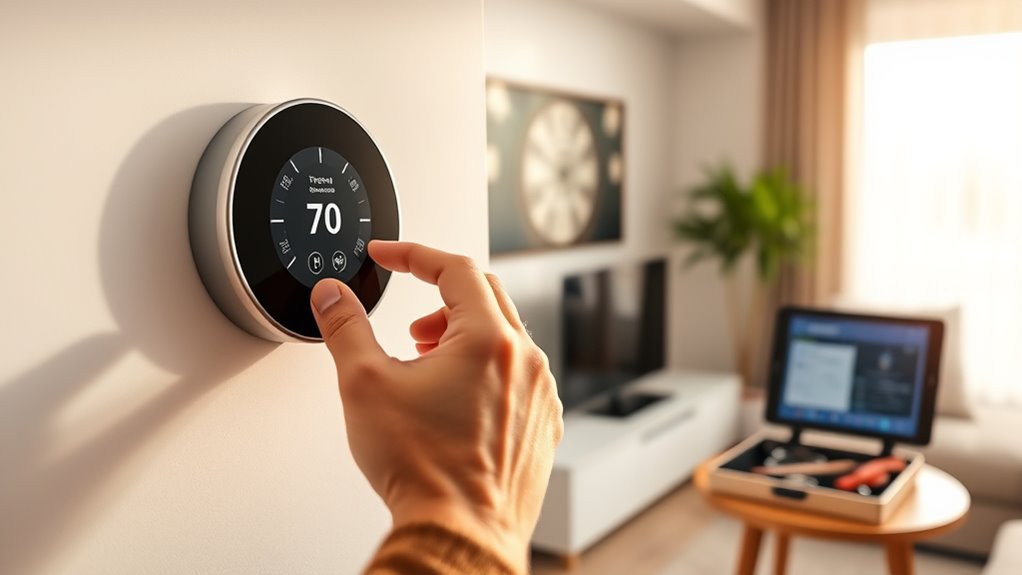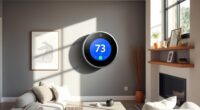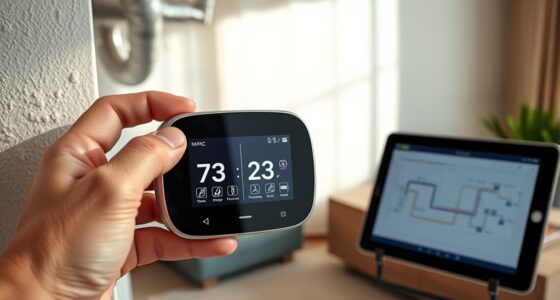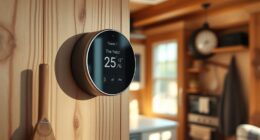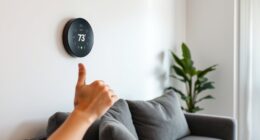To set up smart thermostat access for tenants, choose a device that supports multiple user profiles and remote control with strong security features. Create individual accounts for tenants, assign permissions to limit their control to only their units, and share access securely using app invitations and multi-factor authentication if available. Regularly review permissions, update them when tenants move or change, and monitor system activity to prevent unauthorized access. Continue exploring ways to balance convenience and security effectively.
Key Takeaways
- Choose a secure, compatible smart thermostat supporting multiple user accounts and remote access features.
- Create individual user profiles with tailored permissions limiting tenant control to their unit.
- Share access securely via app invitations or secure login credentials, emphasizing responsible use.
- Regularly review and update permissions, promptly removing access when tenants move out.
- Enable multi-factor authentication and monitor system activity to enhance security and prevent unauthorized access.
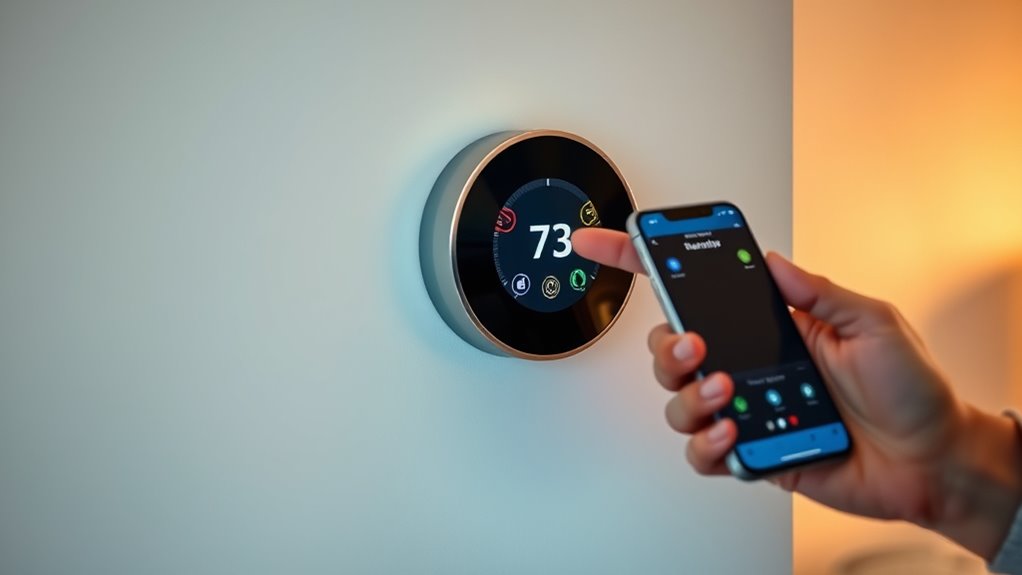
Setting up smart thermostat access for tenants guarantees they can control their comfort while you maintain security and management efficiency. To do this effectively, you need to establish a system that allows tenants to remotely access the thermostat without compromising security. Remote access is the cornerstone of a tenant-friendly setup, enabling tenants to adjust their heating and cooling from anywhere via their smartphones or computers. This convenience not only enhances their experience but also reduces the number of maintenance requests related to temperature issues. However, enabling remote access requires careful management of user permissions to guarantee that tenants can only control their designated units and do not interfere with shared or building-wide settings.
Allow tenants remote thermostat control while maintaining security through proper user permissions and access management.
Start by choosing a smart thermostat that supports multiple user accounts and remote access capabilities. Once installed, you’ll need to create user profiles for each tenant, assigning specific permissions based on their unit and access needs. For example, tenants should be able to adjust their thermostat settings but not alter overall system configurations or access other tenants’ units. Clear user permissions prevent accidental or malicious changes that could impact security or energy management. Most smart thermostats offer an app or web portal where you can easily set these permissions, giving tenants control within predefined limits. Additionally, selecting thermostats with high security standards can further protect against unauthorized access and potential breaches. Ensuring the system supports multi-factor authentication can add an extra layer of security and peace of mind.
Next, you’ll want to share access details with tenants securely. Provide them with login credentials or invite them via the app, depending on the system’s features. Educate tenants on how to use the app responsibly, emphasizing the importance of not sharing login details and respecting the boundaries of their permissions. This step is vital for maintaining control over the system while empowering tenants to manage their comfort. Also, consider setting up multi-factor authentication if available, adding an extra layer of security to prevent unauthorized access. Regularly monitor and update user permissions to adapt to changes, such as new tenants or lease terminations. Remove access promptly when tenants move out to prevent lingering control over the system. This ongoing oversight ensures your smart thermostat system remains secure and efficient. Additionally, keep tenants informed about any updates or changes to the system, so they understand their capabilities and limitations.
Frequently Asked Questions
Can Tenants Change Thermostat Temperature Settings Remotely?
Yes, tenants can change the thermostat temperature settings remotely if you set up remote control access. With a smart thermostat, they can easily adjust the temperature for comfort or energy savings from their smartphone or device. Just guarantee you’ve granted them access through the app or platform, and they’ll be able to make quick temperature adjustments anytime, anywhere, without needing physical access to the thermostat itself.
What Security Measures Protect Smart Thermostat Access?
When it comes to remote access, security protocols are essential to protect your smart thermostat. You should enable strong, unique passwords and two-factor authentication to prevent unauthorized access. Regularly update the device’s firmware, and limit access permissions to trusted tenants only. Additionally, use secure Wi-Fi networks and monitor activity logs to detect any suspicious activity, ensuring your smart thermostat remains secure against potential threats.
How Do I Revoke Tenant Access if Needed?
They say “it’s better to be safe than sorry,” and that’s true when it comes to tenant privacy. To revoke tenant access, log into your smart thermostat’s app or dashboard, navigate to the user management section, and select the tenant’s profile. Then, choose the option to remove or disable their access. This guarantees you maintain control and protect your property, especially if access needs to be revoked quickly or for security reasons.
Are There Legal Restrictions on Tenant Thermostat Control?
You might wonder if there are legal restrictions on tenant thermostat control, especially regarding privacy concerns and access permissions. Laws vary by location, but generally, landlords must respect tenants’ privacy and provide reasonable notice before accessing or adjusting thermostats. You should review local regulations to ensure you’re compliant. Clear communication and written agreements help balance your access needs with tenants’ privacy rights, avoiding legal issues.
What Troubleshooting Steps if Tenants Can’t Access the Thermostat?
When facing issues where tenants can’t access the thermostat, remember that a problem shared is a problem halved. Start with remote troubleshooting by checking internet connectivity and device compatibility. verify user permissions are correctly set—sometimes a simple oversight blocks access. Confirm tenants are using the right app version and login credentials. Clear cache or restart the device if needed. These steps often solve access issues faster than you’d think.
Conclusion
By following these simple steps, you’ll open a stress-free way to manage your property’s climate—saving you time, money, and headaches that could rival a hurricane. Giving tenants smart thermostat access is like handing them the keys to a futuristic home, making everyone’s life easier. With clear instructions and secure access, you’ll create a seamless experience that keeps your tenants comfortable and your property running smoothly—proving that a few tech tweaks can transform your management game entirely.
